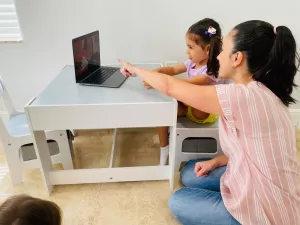How to Build Engagement with your Child
Is your child so “busy” that you find it difficult to engage with them? For example, you talk to them and they almost seem to “ignore” you? Or you attempt to play with them, and they are not reciprocating? You’re not alone!

Playing with your child is an excellent way to build engagement and joint attention. Not only does playing together increase the sense of bond, but it also positively influences overall development. Research indicates that a new skill is acquired between 10-30 trials through play; however, that same skill may take up to 500 trials to master when “teaching” the skill in a non-play opportunity. Thus, play is essential.
So how can we enhance overall engagement through play, when it seems like your child is uninterested?
Below are some tips and strategies on how to build engagement with your child:
- Observe, observe, observe
-
-
- Sometimes, it might seem like a child is not engaged with anything and “in their own world”, but most likely than not, they are engaged with something! It might just be something that is less predictable. For example, perhaps instead of being engaged with toys, your child is more engaged with staring at the ceiling fan… playing with the TV remote… or playing with a zipper on a sweater. Whatever it is, talk to your child about what they’re engaged with. It is important to follow their lead and get on their eye level.
-
- Join in on what they’re doing
-
-
- It is important to not alter what they are doing, even if it may be an “incorrect” way of playing. It is okay to show your child how to play, but try not to force it upon them, as it may cause frustration. Instead, join in the play, and input information to build new skills.
- For example, if your child is interested in repetitive play with a zipper, join in and add functional core vocabulary (e.g., “Wow! Zipper UP, Zipper DOWN”… “Zip-zip-zip FAST, Ziiiiiip SLOW”). Or perhaps your child is interested in a corner of a table. Use that same corner of the table and add a toy that is about to “fall” off (e.g., using a toy car, pretend that the car is falling off a “cliff”, using that corner of the table (e.g., “Uh oh! Car is falling! Help help!”)
- Tip: Remember to use high-pitched, excited voices, as well as concise language. If you are genuinely happy and intrigued to learn about what they’re interested in, they will sense that!
-
- Repetition & Patience
-
- If it doesn’t work the first time, that’s okay! In fact, that’s almost to be expected. You may feel like you’re joining in on what your child is doing, and they’re still not noticing. Keep going. Eventually there will be a break-through. Many believe that if a child is not making eye contact, they are not absorbing the same information that you are. However, a child still is using peripheral vision, and is taking in information from all angles.
- Repetition, patience, and positivity are key. It won’t always be easy to keep that mindset, but trust that it makes a difference and keep going.
If you are interested in learning more and live in Florida, please reach out to Exceptional Speech Therapy, as our trained speech-language pathologists and occupational therapists are happy to assist and determine your child’s individualized needs.
Happy Playing!
-Andrea Scola, M.S., CCC-SLP Exceptional Speech Therapy Blog Writer

